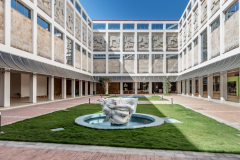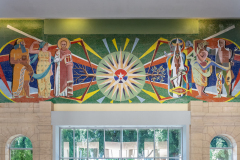National Musem of Fine Arts
Alfonso Rodríguez Pichardo
Habana Vieja
1954
The enormous modern palace with a large patio and adjacent porticoes occupies an entire block and incorporated works by some of Cuba’s most respected contemporary artists.[i] Rita Longa’s marble sculpture Forma, Espacio, Luz (Form, Space and Light) stands at eye-level on the front façade.[ii] High above the entrance on a projecting balcony rests Mateo Torriente Bécquer’s cement abstract composition inspired by Afro-Cuban musical instruments. The four corners of the building’s two lateral facades also contain sculpture groups by Juan José Sicre, Teodoro Ramos Blanco, Alfredo Lozano, and Ernesto González. Within the building, the patio has a running frieze of abstract relief panels by Ernesto Navarro, and the entrance vestibule contains a magnificent ceramic mosaic by Enrique Caravia.
[i] Enrique Caravía, “El Museo Nacional,” Arquitectura, no. 214 (May 1951), pp. 231-34; Idem, “El Museo Nacional,” Arquitectura, no. 254 (September 1954), pp. 403-08; Album de Cuba, Vol. 3, n.p.; Corina Matamorros Tuma, “Apuntes históricos del Museo Nacional de Bellas Artes,” in Guía Arte Cubano, Roberto Cobas Amate and Antonio Eligio Fernández (eds.), Havana: Museo Nacional de Bellas Artes, 2002, pp. 9-15; José Linares Ferrer (ed.), El Museo Nacional de Bellas Artes: Historia de un proyecto, Havana: Oficina de Publicaciones del Consejo de Estado, 2003, pp. 44-53; Rodríguez, The Havana Guide, p. 202; and Gómez Díaz, De Forestier a Sert, pp. 311-12. On the Colón market, see Weiss, La arquitectura colonial cubana siglos XVI al XIX, pp. 398-99.
[ii] Pérez Pérez and Álvarez-Tabío, Rita Longa, p. 62.


